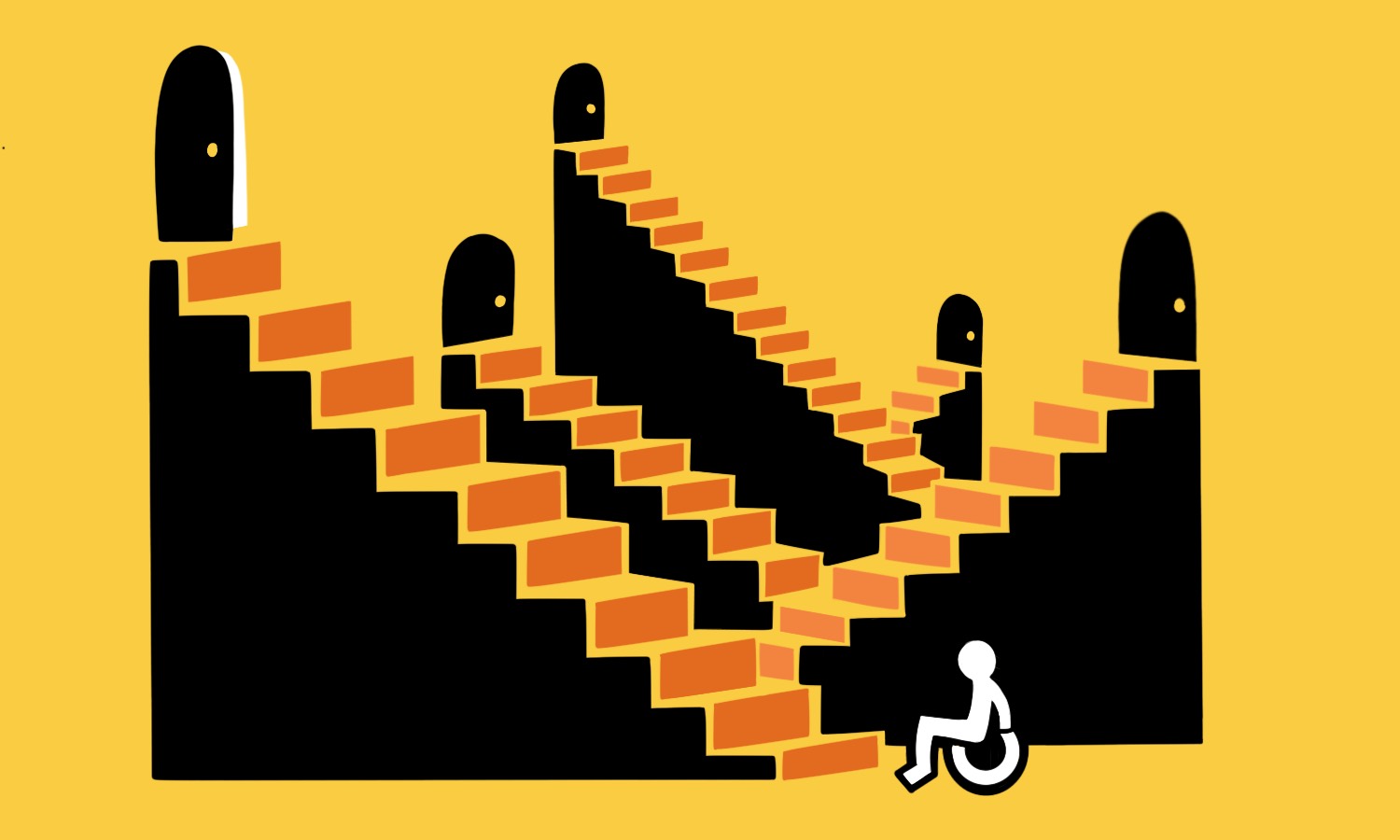“If we were able to keep our income, we’d have been married a long time ago.” Sherri Daniel, who has spinal stenosis and achondroplasia, a form of short-limbed dwarfism, currently receives Supplemental Security Income (SSI), while her fiancé, who has cerebral palsy, receives Social Security Disability Insurance (SSDI). If they were to marry, however, government restrictions would cut off most of Daniel’s SSI, forcing the couple to choose between marriage and poverty. This situation is all too familiar for people with disabilities in the United States.
According to a 2017 report from the National Council on Disability, despite accounting for about 12 percent of the working age population, people with disabilities make up more than 50 percent of those living in long-term poverty in the United States. This disparity is deeply concerning and indicative of larger systemic problems that make it difficult for people with disabilities to escape poverty. The first step to achieving economic justice and equality for this group is understanding how these problems manifest within American policies like subminimum wage, SSI, and SSDI, all of which are fundamentally structured to be hostile toward people with disabilities.

Employment discrimination poses a significant economic barrier to individuals with disabilities. The Americans with Disabilities Act (ADA) makes a weak attempt to ensure employment equity, stating that employers may not discriminate against a qualified candidate based on their disability and must provide them with reasonable accommodations if hired. Yet, there is a way around even this bare minimum requirement. Employers may deny people with disabilities a job or necessary accommodations if they feel that it causes them “undue hardship,” a vague term that can be applied even to minor inconveniences. This loophole helps explain why the unemployment rate in 2020 was 12.6 percent for people with disabilities, as compared to 7.9 percent for people without disabilities.
Another policy obstacle confronts people with disabilities who are able to find jobs despite the discrimination in the process: the subminimum wage. The Fair Labor Standards Act allows employers to request a certificate from the Department of Labor that lets them pay lower wages to anyone “whose earning or productive capacity is impaired by a physical or mental disability.”
The Fair Labor Standards Act has had dire consequences for the approximately 100,000 to 420,000 workers with disabilities who are currently making subminimum wage—estimates of the average subminimum wage range from $2.15 to $3.34 an hour. Although the original law’s intent was for workers to eventually reach “full productivity” and then receive at least a minimum wage, this goal is rarely realized. Ross Ryan, who has an intellectual disability, spent 22 years working at a sheltered workshop that was supposed to provide training and serve as a transitional job for people with disabilities to enter or return to the mainstream workforce. Working for a subminimum wage, Ryan was never able to become financially independent, and thus felt “trapped in a sheltered workshop for most of [his] adult life.”
The subminimum wage fundamentally abandons the principles of a minimum wage and reinforces the ableist assumption that the value of a person with a disability’s work is inherently less than that of a person without a disability. It is illegal to pay an unproductive worker without a disability a subminimum wage, yet people with disabilities are often subject to wage constraints even when productivity is down for reasons outside of their control.
Ironically, the minimum wage is not intended to be a measure of productivity at all but a guarantee that all working people can afford to support themselves and their families. This is a right not afforded to people with disabilities.

Critics argue that the subminimum wage should not be a concern, since people with disabilities are supposed to receive financial support from the government through SSI, which provides both a stipend and Medicaid eligibility to its recipients. But to be eligible for SSI, a person cannot have more than $2,000 in resources. SSI defines resources as any liquid asset, excluding necessary assets like homes or a single vehicle from this resource calculation. Still, the $2,000 resource ceiling is preposterous, as it becomes nearly impossible to save up enough money for an exempted asset while staying within the ceiling’s limit.
Moreover, SSI support is rarely enough to allow for a high quality of life. In December 2020, the average SSI payment was only $580 per month, equating to an average annual payment of only $6,960. The average cost of living in the United States (only including food, electricity, and rent) is $28,586—meaning that SSI is nowhere near enough to cover basic needs. Those who live with someone who supports them, whether they are family, friends, or a spouse, receive even further reduced SSI payments and risk completely losing their benefits. Furthermore, with the resource limit for a couple set at $3,000, disabled couples often cannot marry without either sacrificing financial assets or giving up SSI benefits entirely.
SSDI is a program without resource limits that may offer some hope for people who worked for several years before they became disabled and can no longer do the same work as a result of their disability. However, the requirements for SSDI are extremely restrictive: Recipients must have earned a significant amount of Social Security work credits prior to becoming disabled, and they must have a disability that prevents them from doing any work. These strict requirements mean that very few applicants actually qualify for SSDI. For those looking to receive SSI or SSDI, it is imperative that the system is reformed so that people with disabilities can more easily obtain and retain benefits.
American institutions and policies are clearly structured in a way that maintains economic inequality for people with disabilities, and it is due time for a change. The country must remove these obstacles and treat people with disabilities with basic dignity and respect. In order to create a more equitable society, we must critically examine the way all of our systems impact people with disabilities. Countless changes, including the elimination of the subminimum wage and the SSI resource limit, are needed to ensure that people with disabilities have the support they need to not only survive but also to thrive.

As someone who has worked with adults with disabilities for almost 10 years, including in workshops; I find the problem at it’s roots to be with insurance in America. The majority of the clients I have worked with over the last 10 years fear losing their SSI and Medicaid as a result of working a higher paying job. Losing SSI wouldn’t be so bad if they could get a job to support themselves, but the rate of insurance in this country is disgusting even under the so called “affordable care” plan. The only way my clients are able to get the supports they need are if they are on Medicaid. They have to be on Medicaid. Most funding for the supports they need are only available to folks that receive Medicaid. The expenses are so great that not even a neurotypical person receiving higher wages and company insurance could afford them. When I was making requests for my clients to live on their own, the cost in these requests for housing and staff that could support them are sometimes over $500 per day. Just for them to live in a house independently away from those who have cared for them since birth. (and those staff people are low paid as well….no degrees, right out of high school). That doesn’t include the cost of work supports, transportation, or food and clothing expenses. We have people trained to work with people with disabilities that can tell them “how much” is “too much” to make before they are at risk of losing their supports regardless of whether they work in a workshop or Walmart. As a parent of an adult child with a disability, I see the side where making too much money costs her everything. She makes minimum wage and is out there working 40+ hours a week, but doesn’t have time to even take care of herself. She doesn’t even have a primary care doctor because she can’t afford to take time off work and still have enough money to pay rent, utilities, and food. Sure she takes advantage of what she is able to get. She has medicaid and food stamps…but she doesn’t even have the time to ask for the supports she needs much less schedule and attend appointments. And don’t get me started on transportation. The system is broke. That is abundantly clear, but most people making subminimum wages aren’t trapped by employers who pay them subminimum wages. They are trapped by a system that places giant obstacles in between them and the supports they need.
Shame on America
The subminimum wage for people with significant intellectual disabilities is not intended to give people income to support themselves. The reality for this small select group of individuals is that they will NEVER be self-sufficient. Even if my son won the lottery tomorrow, he would still be dependent on others to care for him. My son is one of the lucky few remaining in our state with a job at an employment center. He is very well-matched to his job. The light assembly work is something he understands, can do well, and enjoys. He has tremendous job satisfaction. However, he works at about half the speed of a person from the regular work force, as do most of his co-workers. Because of this, he makes about $4.00 an hour, which is reasonable pay for someone who can only do simple tasks at about half-speed and needs constant supervision. If forced to pay these hard-working but less-productive folks the full minimum wage, the company will pull the contract from my son’s employment center and simply automate the work. The company must compete with other manufacturers, so they can’t just ignore costs and pay any amount. People seems to think if 14(c ) were eliminated, suddenly employers could afford to pay thousands of disabled workers more money, but the reality is, those employers will replace low-productivity disabled workers with non-disabled workers. And while people believe it’s fine to end employment of those with significant disabilities for the greater good of others, I can tell you my son will be devastated. Work is so much more than a paycheck, as most of us know. It provides meaning and structure to his days, the company of friends, and co-workers who like him, not with the condescending tolerance of the non-disabled who think he’s “sweet”, but truly like him as a friend and equal. He has so much pride in being a working man, and it is 14(c ) that makes it possible for him. Maybe you see someone like my son and thinks he’d be better off at home watching TV or maybe coloring at an adult care center. My son will tell you no thanks, he’d rather work, because that’s what adults do. And isn’t this what choice and self-determination are all about? If my son is well served by the 14(c ) provisions—if it means he can work and do a job he freely chooses—maybe we should support that. I’m all in favor of increasing opportunities for all people, including those with moderate disabilities, and there is no rational reason that we can’t have both. Let’s have job supports for those can work in the regular work-force with a little help and continue 14(c ) group employment for those who need more support (and less interference from well-meaning people).